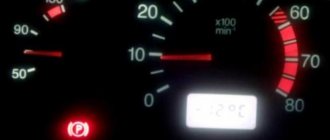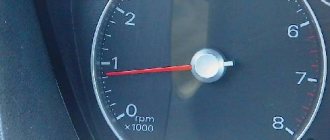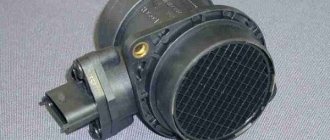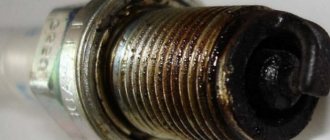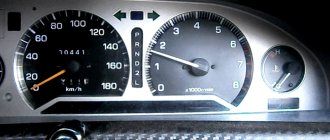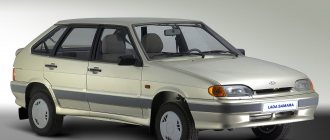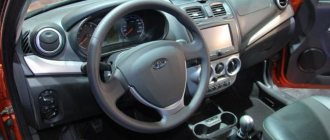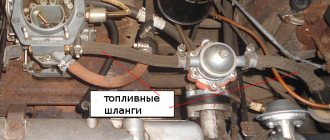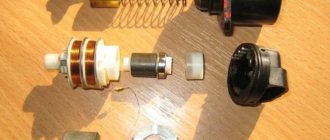The clean and stable operation of the engine of any car often depends on a variety of different factors. If on our VAZ-2114 engine vibration at idle makes itself felt at least from time to time, it is necessary to urgently take action, since, as doctors say, inaction is like death. In the case of any engines that were installed on the “fourteenth model,” there is no need to hesitate, regardless of whether it is an injection engine or a carburetor. Vibration and floating idle can be harbingers of very serious breakdowns, which are easier to prevent than to fix.
Signs of incorrect engine operation
Vibration that occurs when the engine is idling (and often accompanied by floating speed) can be a very serious sign of engine malfunction, which can ultimately cause failure. That is why, as soon as engine vibration at idle speed of the VAZ 2114 is noticed, you should immediately begin to search for its cause. The main signs indicating vibration as a result of malfunctioning engine are:
- strong vibration of the engine immediately after starting, accompanied by floating speeds ranging from 800 to 2,000;
- “disappearance” of idle speed during a trip (when coasting);
- increased vibration when the engine is overheated.
In short, any engine vibrations at idle require the most prompt diagnosis. And we will check those systems and components that can lead to malfunction most often.
Rubber
There are often cases when vibration when accelerating appears due to the installation of low-quality tires. Most often these are tires from budget and extra-budget manufacturers. The peculiarity of such rubber is that when checking on a balancing stand, a discrepancy that causes discomfort when driving a car may not be noticed. In the second case, balancing only temporarily delays the reappearance of vibrations. Only replacing the tires will solve the problem.
The next reason for the appearance of unwanted vibrations is typical for owners whose car is shod with low-profile tires. The side cord of such tires does not have the rigidity and elasticity that is inherent in civilian versions of tires. Therefore, prolonged downtime, especially in the warm season, can cause temporary deformation of the tire at the point of contact with the road surface. Therefore, vibration during acceleration may be observed for a short time after the start of movement.
The first kilometers should be covered with extreme caution.
Uneven wear
Asymmetric wear of the tread on the tire and the appearance of “bumps” will lead to the fact that the suspension elements will experience additional vibration load. Of course, the whole car as a whole will vibrate at speed.
Wheel bearing
If at speed you not only vibrate, but also hear a hum, then you can say with confidence that the wheel bearing has failed. The situation is quite normal, so at the beginning of the problem, operating the car will not cause any consequences. But there’s no point in delaying repairs. Overly worn bearings can fly apart, which will certainly lead to disastrous consequences.
A malfunction of this unit is indicated by wheel play. To diagnose, hang up the wheels and shake each of them in the longitudinal and transverse directions. The play will be a signal for an immediate replacement.
Suspension and steering
Worn suspension elements cannot cause constant or periodic vibrations when driving. Their purpose is to dampen shocks that come from the road surface. Therefore, a car with a faulty suspension can scour the road, make squeaks or knocks when turning the steering wheel, or make dull or loud “echoes” of obstacles overcome.
To safely drive a car, it is worth solving the problem comprehensively.
Vibration at idle. At gunpoint - ignition
One of the main reasons for vibration at idle in an injection engine is incorrect operation of the ignition system.
Even in the case when the fuel-air mixture is supplied to the cylinder in the required quantity and on time, the passage of a spark, constant or periodic, will certainly lead to vibration. Moreover, at medium and high speeds the engine can operate stably, with nominal fuel consumption and good dynamics.
First of all, we check this:
- Any gaps in spark formation will lead to uneven emission of exhaust gases, you can simply check this with your hand, placing it near the exhaust pipe of the muffler, the gaps will be immediately audible. A working engine should have a uniform exhaust
- Breakdown in the high-voltage circuit . Initially, it is worth checking the high-voltage wires - they should not hit ground both along the entire length and in places of contact with the coil and spark plug cap. A breakdown of high-voltage wires can cause engine vibration
- Candles . Quite often they can malfunction at low speeds due to a breakdown in the housing. In this case, a dark brown or black coating will be clearly visible along the rim of the insulator from below - the first sign that the spark plug is breaking through to ground. You need to check each spark plug - while idling, you need to remove the caps one by one and listen to see if the engine operation has changed. Faulty spark plugs must be replaced (see “selection of spark plugs for the VAZ-2114 - parameters and clearances”). We check the spark plugs by removing the caps one by one
- Malfunction of the ignition coil (ignition module) . In this case, you can check the functionality only by replacing the module or coil with a known working one.
In addition to these problems, difficulties may arise in the operation of electronics , this mainly applies to injection engines. And only these were installed on the VAZ-2114, with the exception of the Samar-2 line being the VAZ-2115 - there were carburetor versions.
conclusions
In this way, you can independently determine the causes of vibration of the VAZ-2114 engine at idle speed. Good roads to everyone and stable engine operation!
Admin please post!! Greetings! The problem is this: the steering wheel shakes at idle, I checked the airbags, changed the rcx (installed the factory one), cleaned the throttle, adjusted the valves, changed the spark plugs (installed Bosch platinum), changed the VV wires, did diagnostics, there was only one error, an open circuit of the starter relay (I blame the crookedly installed alarm system by the previous owner) tell me how to get rid of this shaking part. Thank you!) I forgot to add, the car is 2113, 10 years old... The steering wheel shakes at idle.
Similar articles
29 comments on “The steering wheel shakes at idle. Steering wheel shakes at idle"
the same problem only in all gears in the range from 2500 to 3200 rpm. I changed a lot of things, don’t understand what to do
I have the same problem with a nine carburetor, increasing the idle speed helps me)
The muffler may be blowing
Sound, Your balancing is either crooked tires or rims! But he doesn’t understand - he speaks at idle
there is such an option... and it also floats idle, I have already changed and adjusted a lot, but the result is the same
Sound, did you flush the throttle body?
I have the same thing!! and do you know what the problem is?
well, don't be tormented, speak up
Sound, many options, it’s hard to guess without a computer, looks like an air leak
Electronics and sensors as causes of vibration
Another suspect in the story of engine vibration at idle is the electronic engine control unit. No one will repair it; most often it must be either replaced or re-flashed. For example, in injection engines with a Bosch 7.9 controller. 7+, flashing ER19 instead of the standard ER16 often helps, fuel consumption remains within normal limits, and vibration disappears.
In addition to the ECU, the following sensors may be to blame:
- Idle speed regulator . The regulator sensor is mounted on the throttle body, and to check it you need to remove the terminals and use a multimeter in ohmmeter mode to check the resistance between the contacts. The nominal value is 60-80 Ohms. If the sensor does not produce the required resistance, replace it with a new one. Check the idle air control
- Mass air flow sensor . If this sensor malfunctions, the pulse it sends to the ECU will have an incorrect value, therefore, the engine may vibrate at idle. The sensor is checked in the same way as the previous one, but the multimeter is set to voltage measurement mode. With the ignition on and the engine off, the voltage between the sensor contacts should be within 0.9-1 V. Check the mass air flow sensor
- EGR sensor . It is responsible for the recovery of exhaust gases and is an electromagnetic cone valve. It is this valve that requires periodic cleaning. We carry out cleaning with any spray for washing the carburetor or injectors.
Valve timing fault
If vibration occurs in the cabin at idle, the first thing to check is whether the marks on the camshaft sprocket correspond with the marks on the engine cover. If they do not match, it means the valve timing has shifted. As a result, when the fuel mixture enters the cylinders, it ignites unevenly. In addition, it may not have time to burn completely. This leads to the fact that the engine loses power, begins to consume more fuel, smokes, and sometimes even stalls.
The displacement of marks occurs involuntarily. The main reasons for this are: stretching of the timing belt, incorrect tension, incorrect marking during repairs. The same problem can also occur in an engine with a timing chain drive, such as the Z22SE engine. Vibration in the cabin at idle in a car with this power plant occurs due to poor design of the chain and oil nozzle in the timing drive. As a result of the hydraulic tensioner jamming, it ceases to perform its functions and the chain begins to deform.
In an engine with a timing belt, the problem is solved by combining the above marks, which cannot be said about engines like Z22SE. Vibration in the cabin at idle speed in such power plants can be eliminated, as a rule, only by replacing the hydraulic tensioner, and sometimes the entire timing belt kit.
Other causes of vibration at idle
Of course, you should not ignore the power system, and first of all, the injectors and throttle. The throttle must completely block the diffuser , and to clean it, aerosol compounds are used, the same as in the case of the EGR sensor.
Cleaning the throttle valve The performance of the injectors is checked on a stand, and they are cleaned if necessary. In addition, vibrations at idle speed can occur due to excessive wear or failure of the engine mount. The cushion consists of two brackets, one of which is attached to the engine cylinder block, and the second to the body. The brackets are connected to each other by a rubber silent block and a vibration damping cushion. It may crack, crumble, or simply tear. Hence the vibrations at idle.
The engine mount can cause vibrations.
Replacing pillows and preventing spark plug malfunctions
It is worth learning to deal with the most common causes of body vibrations: engine mounts and spark plugs. In the first case, replacing parts cannot be avoided - the rubber from which the parts are made simply wears out and loses its elasticity. There's nothing you can do about it. Replacing pillows is similar to other car models and should not cause problems. To replace you will need:
- Socket wrench 17 with cardan.
- Socket wrench 13.
- Keys for 15 and 19.
- Hydraulic jack.
Read next: How to Clean the Throttle Body on an Accent
If replacing parts yourself causes you difficulties or you lack the necessary tools, the best solution would be to contact a car service center. At the same time, you can select the pillows you need in advance, so as not to wait for mechanics to find them and order them for you.
However, spark plugs, unlike engine mounts, can avoid replacement for a long time if they are properly cared for. If you regularly clean them and monitor the gap between the electrodes, you can significantly increase the period of stable operation without uncomfortable vibrations of the case.
Excess oil in the crankcase, insufficient vehicle load, early ignition - this may be indicated by different colored soot on the spark plugs. Paying attention to this detail can greatly help you diagnose problems.
Ignition problems
The first thing you should pay attention to when vibration occurs is the ignition system.
Most often, it is the cause of floating speed and engine vibration on injection-type cars.
You need to look for faults in the ignition system in the following order:
- misfires. To find out about their presence, just raise your palm to the exhaust pipe - if there are gaps, it will be immediately noticeable;
- breakdown of high-voltage wires. You can check their condition either using a megohmmeter (the external resistance of the wires must be no less than the value indicated on their shell), or by installing other wires that are known to be in good working order;
- breakdown of spark plugs on the body. It is this that often causes vibration to spread throughout the interior of the VAZ 2114. You can find out about the presence of such a breakdown by the rim of the insulator, covered with a black or dark brown coating;
- ignition module malfunction. It should be checked last (since this element fails much less often than wires or spark plugs), replacing the device with a new one.
Do not forget that if the cause of the problem is the spark plugs, then you should replace not only the faulty spark plug itself, but also all the others. Checking spark plugs in VAZ 2114.
Answers:
— Measure the compression in the cylinders, it should be the same.
— eliminate the floating of revolutions, this is a common phenomenon (vibration, that is) in this situation.. how? This is a separate topic, a lot has been written about this, but the compressor and ignition are usually not relevant here... use the search, it’s a million..
— There are a million reasons... from the spark plugs that you changed... new ones do not mean that they are working... to the engine mounts... Just look and check, in short, look and only... Two days ago I changed the spark plugs to a new set... everything seems to work. But something is wrong... in the end the spark plug the second cylinder even in color...replaced the ass with an old one but it’s working and in order...this is an example...
— They measured the compression... the master said it was ideal. But of course he could have deceived me... It’s just that the tachometer needle twitches quite a bit, so I didn’t think that IAC, for example, was guilty. Yes, and a computer. the diagnostics showed nothing (The service center where all this work was carried out said that vibration is normal and it would take too long to find the cause. But I don’t agree with them... They also say that there are valves in the oil filter that prevent oil from draining into the crankcase They don’t know anything! And when I came to them with the problem of the oil can going out 2 seconds after the start, they said that the filter could not possibly be in use. Post edited by JokerOK: July 10, 2011 - 08:48
— Rinse the throttle body with carb fluid, it’s better, of course, to completely remove the unit, at the same time clean the IAC valve, and wash the valve jet, and the damper itself and the channels...
— The same nonsense, the speed and vibration fluctuate a little, although the car is new and only has 600 km of mileage!!!
— I would go under guarantee if I were you. Let them fix it, this is not the case on a new car!
- I had the same crap. If you have 1.6, then air leaks through the plastic receiver are possible. It consists of two halves, I had gaps between them. There was also a suction through the mass air flow sensor, bypassing the filter, the mass air flow sensor was covered in dust. Someone’s hands could have been torn off. It could be from anything: spark plugs, ignition valves, explosive wires, fuel system, valves. Message edited by m104: August 16, 2011 - 10:10
Based on materials from the Lada Forum: lada-forum.ru
Electronics problems
If after checking it turns out that the ignition system is fully operational, you should pay attention to the on-board electronics, and first of all, to the electronic control unit. If it fails, it will not be possible to repair it, since it is not a repairable device.
If the ECU is working properly, then you should check the idle speed sensor.
To do this you will need:
- Remove the sensor.
- Disconnect the terminals from it.
- Turn the multimeter into ohmmeter mode with a range of up to 200 Ohms and attach its probes to the sensor contacts. If the latter is working properly, then the resistance will be in the range from 50 to 80 Ohms. Otherwise, the sensor should be replaced with a new one of a similar model. Checking the idle speed sensor of the VAZ 2114. The next step in troubleshooting will be checking the mass air flow sensor.
It is performed according to the following scheme:
- Disconnect the terminals from the sensor contacts, and then connect the multimeter probes to the latter.
- Set the tester to voltmeter mode with a range of up to 2 volts.
- Take voltage measurements with the engine running and off. If the sensor is working properly, in both cases it should be in the range from 0.9 to 1 volt.
If the air flow sensor also turns out to be working, then the problem should be looked for in the EGR sensor, which is responsible for exhaust gas recovery. This device, which has a conical shape, does not need to be checked with a multimeter - it is enough to blow it with any spray to clean the injectors or carburetor (by the way, such cleaning should be done periodically, regardless of the correctness of the current operation of this sensor).
Checking the spark plugs
It is better to start checking the system with spark plugs. First of all, you need to start the engine and warm it up to operating temperature. Then you need to set the minimum idle speed (from 800 to 1000, depending on the engine type). If the engine runs rough and vibrations appear, then you need to check the spark plugs. This is done quite simply - you need to remove the caps of the candles one by one. If, when removing the cap, the engine begins to vibrate even more strongly or stalls completely, this spark plug and its high-voltage wire are in good condition. Having returned everything to its place, you need to check the remaining spark plugs. If, when the cap is removed, the engine operating mode remains unchanged, it means that the cylinder for which this spark plug is responsible does not work, that is, the fuel in it does not ignite.
To solve this issue, you need to inspect the spark plug itself, its high-voltage wire and distributor. A common problem with spark plugs and wires is breakdown, in which part of the electricity simply goes to ground. This is usually accompanied by a subtle spark.
To check the serviceability of the spark plug, you need to:
- Remove all caps.
- Unscrew the non-working spark plug.
- Put a cap on it.
- Place the spark plug on a surface that has contact with the vehicle's ground (for example, a valve cover).
- Ask an assistant to turn on the ignition and idle the starter.
- Check for spark at the spark plug.
When the starter rotates, a stable bluish spark appears between the electrodes of a working spark plug. If it is missing or has a yellow tint, it means the candle has become unusable. Checking the spark plug only takes place if the wire and distributor are known to be working.
If vibration occurs in the cabin at idle, it is advisable to check the serviceability of all spark plugs
In addition to the integrity of the latter, it is important to pay attention to the presence of deposits and carbon deposits on their electrodes. They can also cause a weak spark. It is imperative to make sure that the gap between the spark plug electrodes is equal to the value specified by the machine manufacturer
It is imperative to make sure that the gap between the spark plug electrodes is equal to the value specified by the machine manufacturer.
Other causes of vibration
If, after checking the ignition system and electronics, the cause could not be found, and vibration still appears after starting the engine, you should check the fuel supply system, namely clean the throttle and injectors. In the first case, any carburetor cleaning product will help, but in the second, you will have to visit the nearest auto repair shop. If cleaning the fuel system also does not give any results, then all that remains is to check the last possible cause - the engine mount. It consists of a pair of brackets attached on one side to the cylinder block, and on the other to the body. At the same time, the brackets are connected to each other by a rubberized silent block, which provides vibration damping and noise reduction during engine operation.
If the silent block material is crumbled, cracked or has external damage, it should be replaced. Very often, such a replacement helps to completely solve problems with both vibration and extraneous noise inside the cabin. VAZ 2114 engine mounting At the end of today’s conversation, we should once again remind you that any excessive vibration of the engine is extremely harmful to it, and it is absolutely not worth postponing the search for its cause “for later”.
Wheels are loose
This problem is easy to identify and fix, as it causes vibration at speeds of 100-120. The VAZ-2110 will make a characteristic dull sound. The problem is the loose nuts and bolts securing one wheel or several. Do not neglect checking, it can be dangerous. The wheel may simply unscrew while driving.
The beating itself is very reminiscent of vibrations on the steering wheel and body when the reason was in the wheels and tires. The difference here is that this shaking begins at low speeds. This phenomenon can be observed at different speeds.
So, we found out for what reasons vibration occurs on the body when driving at speeds of more than 100 kilometers per hour.
Subscribe to topic
Subscribe to this forum
Download/Print theme
Download the theme in various formats or view a printable version of the theme.
Any driver is very alarmed when vibration begins in the body at a speed of 100-120 km/h, and at any other speed in the same way. It's not so much a matter of unpleasant sensations, although they do occur. However, if urgent measures are not taken, long-term vibration begins to affect the geometry of the body - little by little, gradually, but steadily.
Distortion, in turn, leads to disruption of aerodynamics and worsens the car's handling. In addition, it is very likely that cracks will appear in the body - and welding work is one of the most expensive.
Moreover, vibration in any component of the car can cause nuts and bolts to spontaneously unscrew, which can lead to serious complications while driving, including accidents and damage that is difficult to repair. Let’s add here that such shaking can signal problems that are about to turn into breakdowns.
Another filter - fuel
If everything is in order with the air filter, this does not mean that the fuel cell is “crystal clean”. It is worth checking its condition, because as you know, before the fuel enters the cylinder, where it then burns, releasing energy, it also undergoes cleaning. In most cases, this is also the main problem why the car starts to jerk.
The filter element serves to remove various impurities from the fuel, which do not disappear anywhere, but simply accumulate here. And over time, it begins to clog, and gradually its capacity begins to decrease. As a result, this also leads to “fuel starvation” of the engine. We already know its symptom - the car jerking.
In what cases is a car “jerking” detected?
Most cases of car “jerking” are associated with problems with wear of spare parts or clogging of one of the car’s systems. While driving, you can detect vehicle twitching at the following stages:
- When starting only at the beginning of the car's movement;
- When driving at low speeds;
- During a sudden increase in speed;
- When driving at high speed;
- When driving in any mode (periodic shocks at different periods of time).
Cover - bearing - differential
Chevrolet Lanos cars Chevrolet Lanos On Air In Style Low Chevrolet Lanos On Air In Style Low To disassemble the differential, undo the cotter pins and unscrew the bolts connecting the cups. During disassembly, the gearbox housing and differential bearing caps are not disassembled, since they are processed together. The left and right differential cups and the conical pair cannot be disassembled either. The main gear and differential are assembled in the reverse order of disassembly.
The differential tapered roller bearings must be preloaded. Initially, the bearings are adjusted so that the axial play is no more than 0 1 mm when checked with an indicator mounted on the differential bearing cover, against the rim of the spur gear. After this, to obtain the correct preload of the differential bearings, the adjusting nuts on both sides are tightened to one groove. In this position, the adjusting nuts are locked, and the self-locking bolts securing the differential bearing caps are finally tightened to a torque of 25 - 32 kgf-m. When adjusting the bearings, the differential must be rotated several times so that the rollers take the correct position between the conical surfaces of the wheels. After assembling the gearbox, the backlash between the teeth of a cylindrical pair of gears should be in the range of 0 1 - 0 5 mm.
It must be remembered that the differential bearing caps are not interchangeable, since they are processed together with the gearbox housing, so each cap must be installed in the place where it was when the crankcase was processed. To avoid damage to the threads on the crankcase, covers and nuts, when installing covers, ensure that the threads on the mating parts match. The self-locking bolts securing the differential bearing caps are first tightened and then loosened enough to allow the adjusting nuts to be turned. The adjusting nuts must be used to establish the correct position of the driven spur gear in relation to the drive gear.
A well-assembled differential with one half-axle gear braked easily rotates by hand. Since the right and left differential cups are not interchangeable, during assembly the marks on the cups are aligned. The cup bolts are tightened until they stop and secured with a cotter pin. The differential bearing caps are also not interchangeable, and they are assembled with the gearbox housing according to the marks.
The differential tapered roller bearings must be preloaded. Initially, the bearings are adjusted so that the axial play is no more than 0 1 mm when checked with an indicator mounted on the differential bearing cover, against the rim of the spur gear. After this, to obtain the correct preload of the differential bearings, the adjusting nuts on both sides are tightened to one groove. In this position, the adjusting nuts are locked, and the self-locking bolts securing the differential bearing caps are finally tightened to a torque of 25 - 32 kgf-m. When adjusting the bearings, the differential must be rotated several times so that the rollers take the correct position between the conical surfaces of the wheels. After assembling the gearbox, the backlash between the teeth of a cylindrical pair of gears should be in the range of 0 1 - 0 5 mm.
When the differential is assembled, the gears should turn easily by hand, without binding in any position. The tightening torque of the self-locking nuts of the differential cup mounting bolts should be within 18 - 7 - 22 kgf-m. Installation of the assembled differential into the gearbox housing must be done after installing the drive and driven bevel gears and adjusting their engagement. The bearing cap bolts must be fully tightened. After installing the assembled differential into the socket of the gearbox housing, the adjusting nuts must be tightened by hand until they fit snugly against the bearings, after which the differential bearing caps are installed.
What is this?
If we talk about the VAZ 2114 model, then there are three supports, two of which are intended directly for the gearbox, and another one for the engine itself.
The main purpose of pillows is to reduce vibrations.
When the car drives, serious vibrations occur, which are transmitted to the body from the power unit. To ensure the necessary level of comfort while driving and not to be distracted by extraneous noise or shaking, special supports are mounted on the car. If you remove them, driving a VAZ 2114 can be compared to riding an old wooden cart.
Causes of malfunctions
The most important problem that pillows face is the loss of elasticity of the material. This is due to the fact that the supports are made of rubber. Over time and with use, these elements lose their original characteristics. Various factors accelerate the wear process of bearings:
- Regular exercise;
- Long service life;
- Cold;
- Heat;
- Temperature changes, etc.
If elasticity decreases, this entails the formation of cracks and delamination of the material.
Replacement is purely a matter of time. But the procedure for changing the front and all other pillows should be carried out on time. If you drive for a long time with worn out bearings, this will result in a negative impact on engine performance. Then the repair will cost much more than the cost of new supports.
The main advice is to periodically check the condition of the supports for wear. If you detect a fault in a timely manner, you can replace it yourself and significantly save on car repairs.
Price issue
If you do everything correctly and in a timely manner, then your costs will be insignificant. You will have to purchase new supports and contact a car service. Of course, it is quite possible to do it on your own. This is a matter of desire and availability of appropriate skills.
Device
Modern automakers use 3 types of idle speed sensor: solenoid, rotary and stepper. For VAZ 2114–2115 the latter type is used. IAC is a stepper mini-electric motor that opens/closes the air duct of the intake manifold of the internal combustion engine, thereby regulating the speed (similar to a bolt on a carburetor).
The IAC design has a ring magnet, a lead screw (needle) and 2 windings. When voltage is applied to the magnet and windings, an electromagnetic field appears. As a result, the lead rotor begins to rotate, thereby driving the lead screw through the worm gear. Depending on the position of the rotor, the needle valve is able to control the opening/closing of the air duct of the intake manifold.
For reference. What is a step? This is the distance between the conical shut-off valve (IAC tip) and the intake manifold. It is measured by the number of full rotations of the rotor.
Breakdown of the vacuum brake booster
As practice shows, not all car owners can associate the braking system with engine vibrations. In fact, brake malfunction often causes vibration processes. Before we find out how such a breakdown is diagnosed, let’s understand its origin.
The vacuum brake booster is connected to the engine intake manifold via a check valve and hose. The last two elements are designed to create a vacuum in the amplifier. This occurs due to the rarefaction of air formed in the intake manifold during the movement of the pistons. Simply put, the check valve sucks air out of the amplifier. If the tightness of the valve or hose is broken, then more air enters the manifold than necessary. This leads to a lean fuel mixture.
